Introduction
Created in 1975 as a programming start-up, Microsoft became a multinational technological giant (Castelluccio 2015). Its revenues in 2014 were estimated to be over 86 billion USD (Chao & Kavadias 2017). Microsoft had been stagnating since 2007, but it saw success under the leadership of Satya Nadella. The purpose of this report is to analyse the organisational design and development of Microsoft, providing recommendations on future development.
Scope and Goals of the Organisation
Microsoft was meant to create opportunities for people and organisations (Gron, Burton, Obel & Hakonsson 2016). Personal computers and dedicated software formed the primary scope of the company. However, Microsoft started defining customer needs and opportunities rather than responding to them. According to Burton, Obel, and Desanctis (2011), organisational goals assessment table for Microsoft at that period of time is as follows:
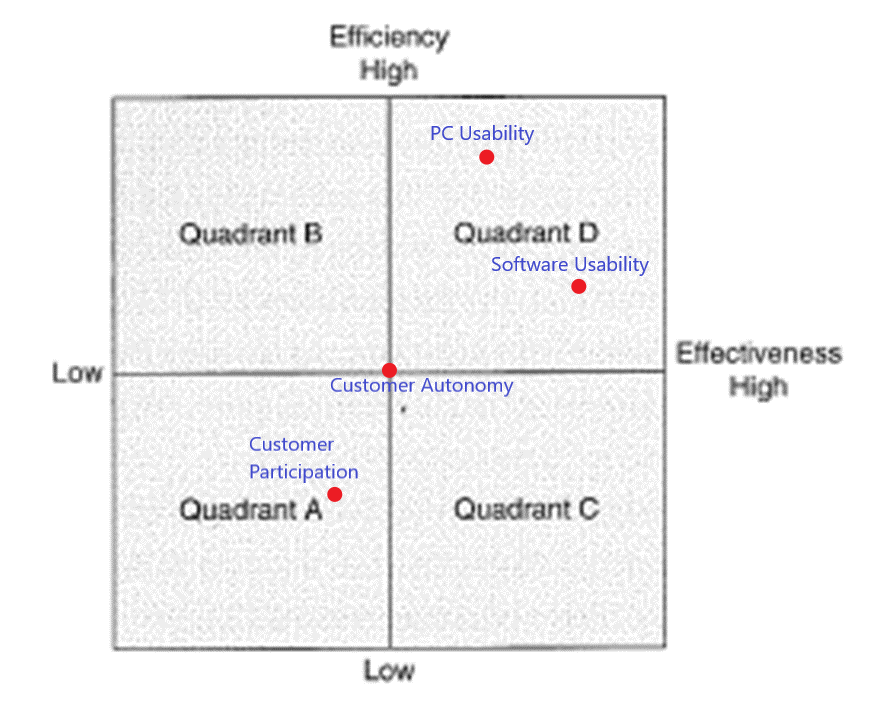
As demonstrated in Figure 1, old organisational scope and goals were largely product-centred, which is a pitfall many large technological corporations fall into (Burton et al. 2011). With the appointment of Satya Nadella in 2014, the scope and goals of the company have been redefined with the emphasis on customer participation, inclusion and autonomy. After the redefinition of organisational goals, Microsoft’s assessment chart became as illustrated in Figure 2:

This transformation, initiated by Satya Nadella in 2014, required significant alteration in organisation design and development. As will be shown below, the strategy, structure, processes, coordination and the overall architectural design needed to be re-evaluated to accommodate the new vision and mission of the company.
Strategy Assessment
Environment
By 2014, the technological market environment offered a significant number of digital products and alternatives to a prospective customer. If prior to 2007 PCs were the primary products of interest, in 2014, computing and mobile markets were thoroughly linked together. Microsoft remained the main provider of PC software systems, but its presence in the mobile market was practically non-existent.
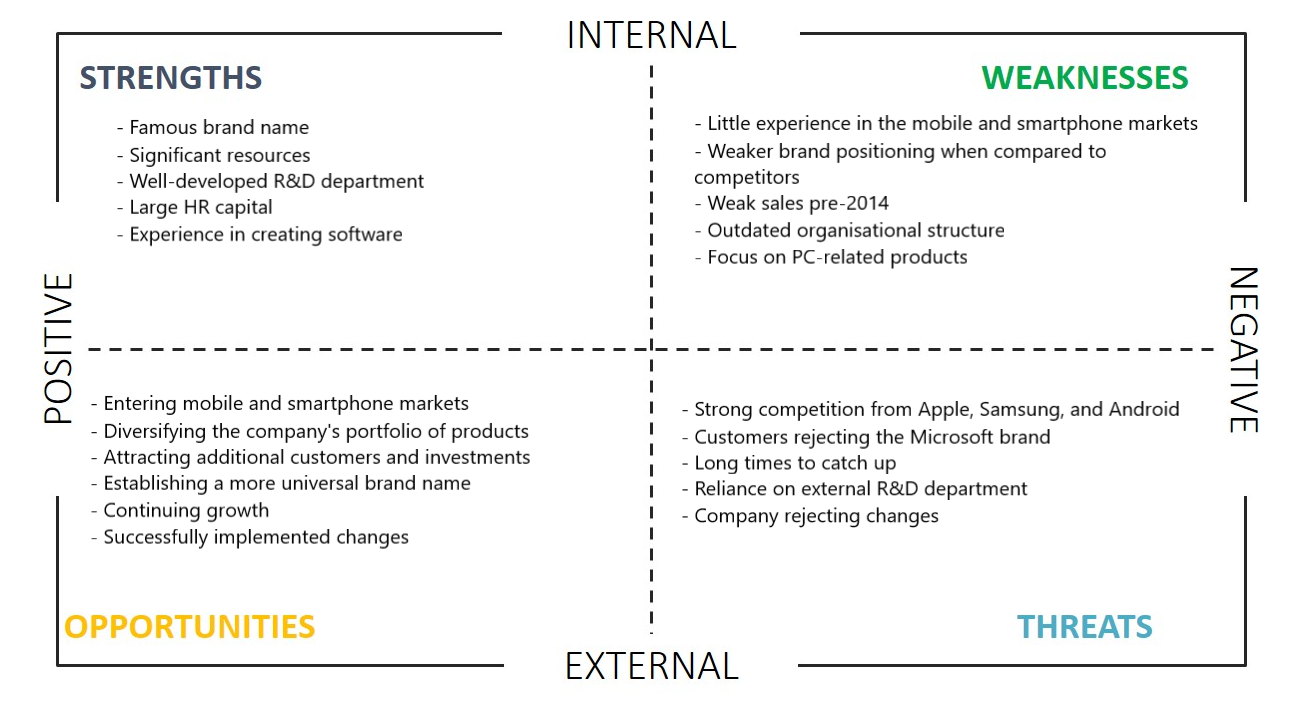
As Figure 4 demonstrates, the company’s threats existed largely in the external environment segment, as Microsoft was entering a Red Sea market with high competition levels. The environmental factors defined the company’s need to adjust its strategy.
Strategy
Under Satya Nadella, Microsoft showed a shift in its strategy, changing the approach from being a defender to that of an analyser with high capacity for innovation (Castelluccio 2015). The Defender strategy was utilised by Microsoft since 2001 (Burton et al. 2011); its main purpose is to capitalise on the company’s natural strengths and positions to generate maximum revenue. The Defender strategy helps generate a stable revenue flow by focusing on the company’s cash cows, but it does not involve technological expansion or the generation of innovative products (Burton et al. 2011). As such, it could lead to a loss of market share, which happened to Microsoft in 2007, with the introduction of smartphones into the digital market.
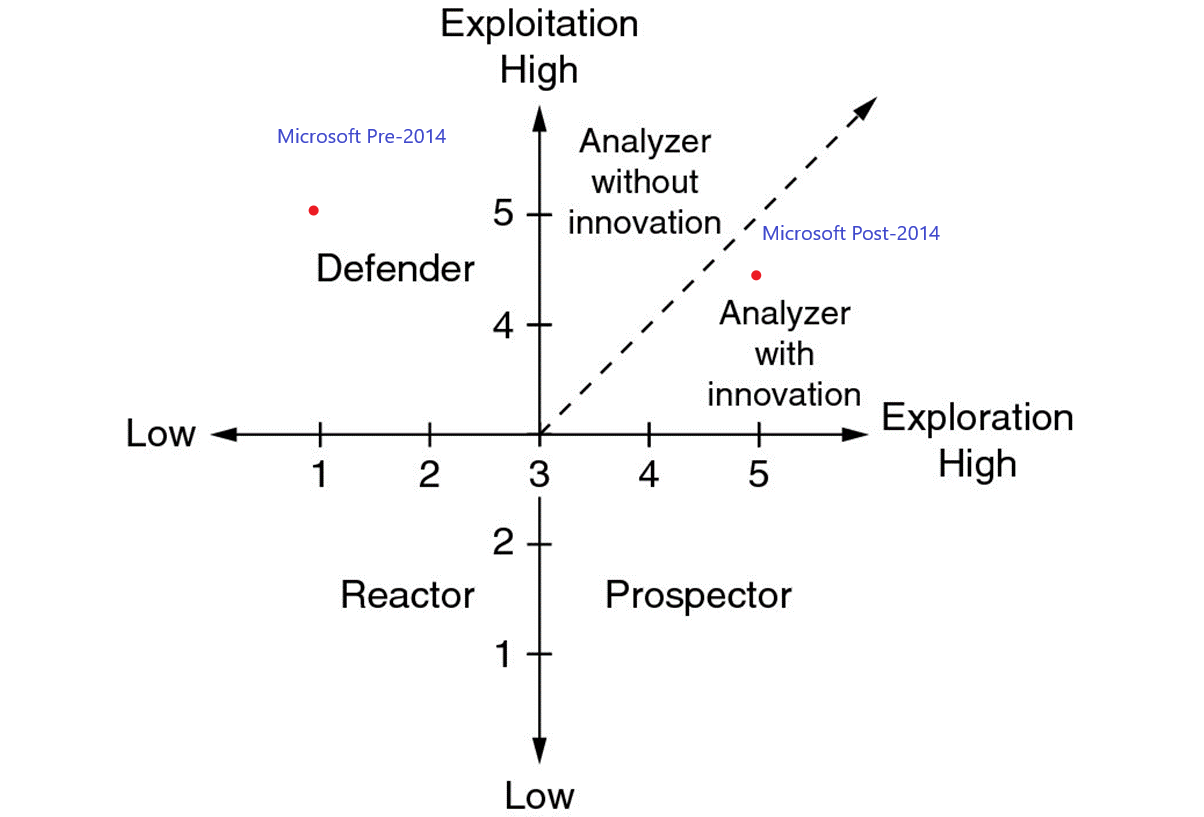
As illustrated in Figure 3, Microsoft’s strategy changed from the Defender model to Analyser with innovation. The company’s profile was going to cater to customers as dual users, shifting the focus from PCs to smartphones, tablets, and software applications. The company’s purchasing strategies since 2014 included Greenbutton (cloud services) and Nokia (mobile division) (Violeta & Diana 2018); its products included a smartphone line, tablets, cloud services (OneDrive) and messengers (Skype). Thus, Microsoft addressed the needs of smartphone users, and the company’s strategy was adjusted to reflect its new goals.
Structure
Old Configuration
Under Steve Ballmer, Microsoft changed from a simplistic to a divisional organisational structure in order to accommodate the rapid expansion of the company due to the increased popularity of its products (Daft 2009). With over 128,000 employees in 2014, Microsoft was organised into five divisions, each responsible for its respective branch of service, which allowed for simultaneous management of different Microsoft-related businesses and projects (see Figure 5).
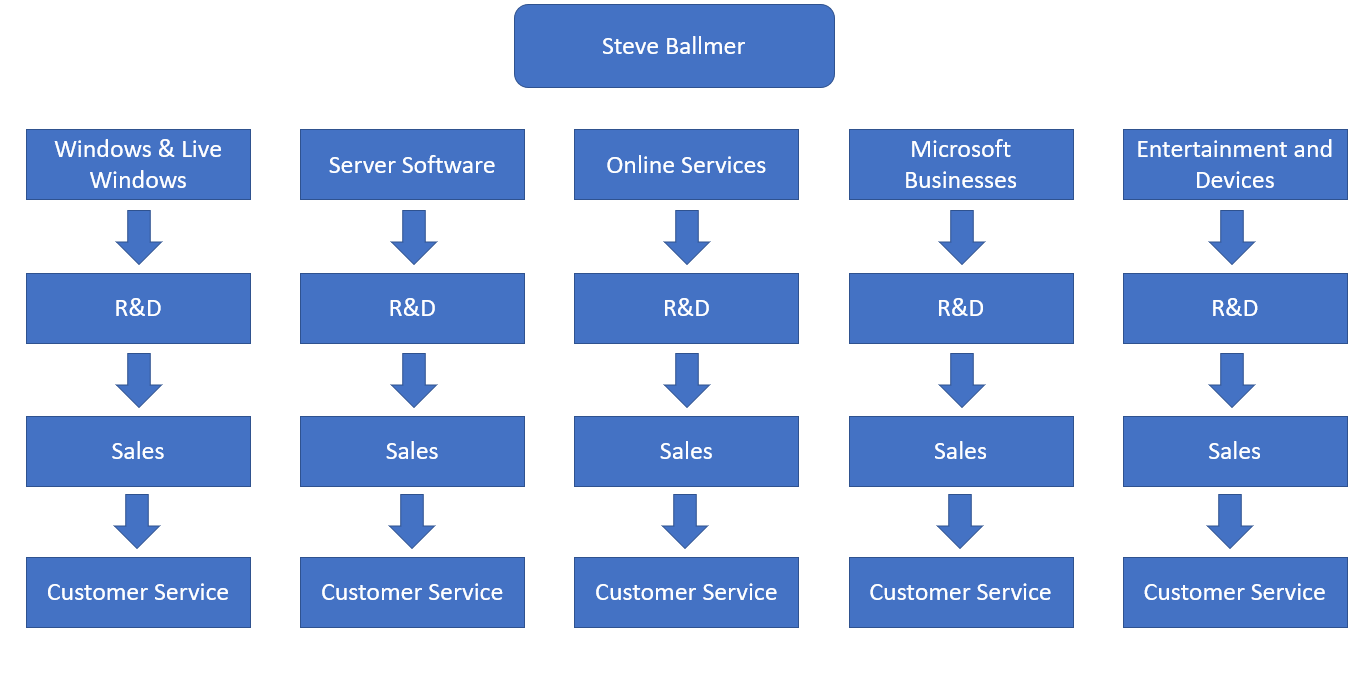
Although this structure provided order and relative stability to Microsoft throughout 2001–2013, it had flaws. The company had five separate R&D, Sales, and Customer service departments, along with the supporting infrastructure. As a result, Microsoft employed far more people than was necessary, which is a common issue for divisional structures (Daft 2009). The system turned into five loosely connected businesses with poor cooperation and coordination.
New Configurational Forms
When Satya Nadella assumed leadership of the company in 2014, he began a reorganisation of the existing divisional structure. Although the divisional framework was retained, the scope changed from being product-based to a process-based functional structure. Instead of competing with one another, individual branches were forced to work together in order to create and promote a unified array of products (Gron et al. 2016). The current Microsoft configuration demonstrated in Figure 6.
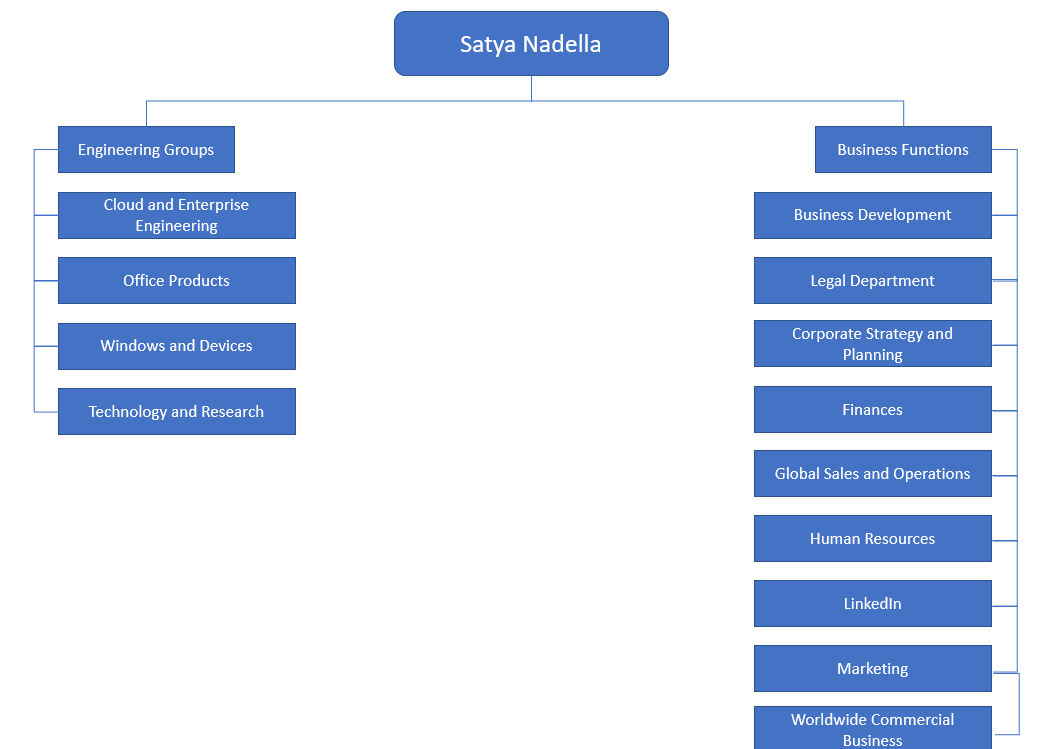
The new system, although divisional at the core level, received plenty of matrix-like connections between different branches (Myers, Hulks & Wiggins 2012). This solution was in line with Microsoft’s attention to innovation since the matrix structure is conducive to the latter (Daft 2009). The new structure helped to reduce the number of employees necessary for corporate functionality by 18,000 positions, eliminated bureaucratic clutter, and allowed the CEO to have a greater degree of control of the engineering and management divisions (Gron et al. 2016).
People and Processes
Task Design
The old Microsoft structure supported an orderly task design. This type of performance is classified by the standardisation of tasks, division of labour, and repetitiveness of performance (Francis, Holebeche & Reddington 2012). However, Nadella’s vision required the development of new products and a more agile and dynamic response time (Gron et al. 2016). Microsoft adopted a knotty type of task design, which is classified by high reliance on inter-segment coordination, non-repetitive working methods, and interdependence between different company subdivisions (Francis et al. 2012), to respond to this challenge.
People
At the start of Nadella’s reforms, the company employed over 128,000 individuals spread across its five divisions (Gron et al. 2016). The initial cuts to the workforce of 18,000 positions were quickly replenished by the expanding R&D department. The increased diversification of products led to further corporate growth. Microsoft’s current number of workers stands at nearly 135,000 positions, meaning that the redundant cutbacks were replaced by productivity (Gron et al. 2016).
Leadership and Organisational Structure
Before the reform, Microsoft had a classical hierarchical structure characterised by multiple levels of vertical management. Although that type of organisation helps distribute responsibility in equal measure, it also makes the movement of ideas difficult. Nadella’s reforms changed that by eliminating several vertical levels and expanding horizontal growth, while also enabling the CEO to have a greater control over the entire structure (Gron et al. 2016). Nadella’s form of leadership is a mix of transformational leadership, which is evident from his quotes and methods of changing Microsoft for the better, with hero-style traditional leadership, which is classified by greater involvement with the system itself (Dartey-Baah 2015). The CEO plays a key role in Microsoft’s decision-making, hence why Nadella sought a shift in power and responsibility in order to exact the changes he sought for the company.
Microsoft (2019) has been prioritizing employee engagement and talent development. The company views these factors as necessary for innovation, employee and customer satisfaction, and various aspects of profitability. Microsoft (2019) reports that it employs open communication and strategic leadership to develop a culture of engagement, thus fostering the involvement of employees in decision-making. One of the specific interventions that have been used to this end is the ThinkWeek, which is an opportunity for employees to reach out to managers and report issues or propose solutions (Tirabeni, Soderquist & Pisano 2016). In general, Microsoft demonstrates an interest in involving employees in decision-making.
Coordination, Control, and Incentives
Coordination, Control and Knowledge Information Systems
Prior to the reforms inspired by Nadella, Microsoft had a relatively fixed working schedule for most of its employees. Lining up schedules was one of the greatest issues with coordination and control on the strategic scale (Ibarra & Rattan 2018). The newly transformed Microsoft puts a greater emphasis on cooperation and coordination between branches, which brought about multiple issues regarding working schedules in different time zones (Voegtlin & Greenwood 2016). In order to facilitate cooperation between branches, Microsoft (2019) uses online schedulers and Extranet software to create virtual workspaces for teams. A greater emphasis is made on flexible schedules and outsourcing (Voegtlin & Greenwood 2016). This information demonstrates the ways in which the human resource (HR) department has contributed to the changes and problem-solving in this company.
Incentives
Microsoft was famous for its high retention rates and generous benefits packages. However, under Steve Ballmer, this loyalty programme saw significant curtailing, which led to greater employee discontent (Tung 2016). Nadella’s leadership shifted the incentives programme towards non-monetary benefits (Williams 2014). Modern Microsoft puts an emphasis on corporate culture and employee empowerment through appraisal, transformational leadership, acknowledgement of critical skills, and training.
Strengths and Weaknesses
General Strengths and Weaknesses
As can be seen from the information presented above, Microsoft’s organization has been dramatically improved under Nadella. Nadella’s changes were informed by a single, unique vision, which made them align well with the general goal of creating a more innovation-focused company. The strength of Microsoft’s new strategy consisted of improved reaction to external factors (in particular, customer preferences and trends in the industry). As a result, in connection to the open systems theory (Burton et al. 2011), Microsoft worked to improve its ability to interact with the environment and respond to the constant changes in it.
The major advantage of the new structure was the improved communication between different elements within the company, especially due to the matrix elements of the approach. It also enabled the new, knotty-type tasks that were chosen for their ability to improve speed and accountability (Gron et al. 2016; Francis et al. 2012). Furthermore, the goal of making the structure more horizontal was a part of attempts to engage employees in decision-making. Given the impact of improved employee involvement on multiple employee, customer, and company outcomes (Gron et al. 2016; Microsoft, 2019), this aspect of Microsoft’s design can be viewed as an advantage as well.
When considering HR factors, Nadella’s approach also exhibits significant strengths. The topic of incentives is particularly noteworthy: as a product of behavioural science, motivation theories indicate that employees can be incentivized in a variety of ways, many of which do not involve tangible benefits (Francis et al. 2012). Therefore, Nadella’s decision to return to the non-monetary rewards may indicate taking into account the potential of intrinsic rewards. The attention to the employee development is significant as well; since Microsoft is an innovation-focused company, employee talent and skills are crucial for its development (Tung 2016). Thus, the current organizational structure and processes have the strengths that are necessary for Microsoft to achieve its goal of becoming an innovation-driven analyser, as described by Burton et al. (2011).
Notably, the improved structure was also associated with a disadvantage: due to the increased need for inter-branch communication, coordination became more complicated. The problem was resolved through the balancing of schedules and shifts, which demonstrates the importance of the role of HR departments in this process. In addition, the company’s own technological solutions facilitated the technical aspect of communication between people from different locations and time zones (Tirabeni et al. 2016). Thus, while it is not without flaws, the company’s new approaches were made functional.
Supporting Change and Status Quo
Since the general aim of Nadella’s changes revolved around fostering innovation and avoiding stagnation, it is reasonable to expect them to support change rather than the status quo. Thus, according to Microsoft (2019) and recent research (Tirabeni et al. 2016), employee engagement is associated with change, improvement, and innovation. Therefore, Microsoft’s attempts to flatten the structure and make its managers approachable can be considered a step toward a change-supporting organizational design. Similarly, the improvement of communication is expected to translate to employee engagement and enhanced information flow and facilitate innovation (CIPD 2018; Microsoft, 2019; Tirabeni et al. 2016). Therefore, the company’s current structure and processes are better equipped to support change than the previous ones.
Still, it should be pointed out that the company’s structure is not flat, and its leadership style is not democratic. The crucial decisions are made by the CEO, as well as other managers, and the company’s attention to its values, mission, and vision can ensure a level of stability while also supporting the status quo (Microsoft, 2019). In addition, Microsoft (2019) notes that the process of engaging employees is complex and not always successful. The latter statement indicates that the company is not fully satisfied with its ability to involve employees in decision-making. Since the support of change and innovation is one of the reasons why Microsoft (2019) attempts to involve employees to a greater extent, this issue needs to be addressed.
Recommendations and Implementation
Recommendations for Change
As can be seen from the above-presented analysis, Microsoft used to employ monetary incentives with its employees before Nadella. With Nadella, the approach was changed, but the company remains dissatisfied with its employees’ engagement, especially when their involvement in decision-making processes is concerned (Microsoft, 2019). At the same time, Microsoft (2019) recognizes the significance of HR in terms of its impact on innovation and change. Given that the company’s primary aim is to ensure its continued development in a continuously changing world, recommendations for the improvement of employee engagement are in order. Here, it is proposed to apply the employee voice model and enhance the use of theories of motivation to the benefit of the company.
The concept of employee voice refers to the effective, factual opportunity offered to employees to voice their concerns, suggestions and other important ideas (CIPD 2017). The analysis of employee voice presupposes considering the mechanisms of and barriers to it (CIPD 2019). Examples of mechanisms can include meetings, surveys, or unions; barriers can involve concerns regarding the risks of making one’s voice heard (for instance, those related to safety or stigma), specific leadership types and the organizational culture that is not supportive of employee engagement (CIPD 2019). It can be reasonably assumed that Microsoft (2019) employs various methods of enabling employee voices and attempts to prevent negative cultural influences from appearing. However, given its dissatisfaction with the outcomes, it can be recommended to review and reassess its system. Specifically, the currently employed mechanisms should be tested directly and applied to resolving a particular issue. In the present recommendation, motivation and incentives are offered for this goal.
Microsoft used to demonstrate a flawed perspective on incentives, which justifies the attention to it. The idea of only using monetary benefits without any intrinsic motivation was proven to be ineffective, which is in line with the currently supported ideas of behavioural science (Francis et al. 2012). The investigation of the most appropriate methods of motivation can be framed with the help of existing theories, for instance, that by Maslow, which is especially helpful in pointing out non-monetary factors that can motivate humans. To ensure that the chosen solutions fit the individual subdivisions within the company, the active engagement of employee voices would be helpful. Thus, this recommendation offers a complex change that would incorporate the application of the currently existing employee voice mechanisms to gather feedback and ideas regarding the improvement of Microsoft’s incentive system. This way, the company will be able to check its ability to engage employees in decision-making while proceeding to improve its means of motivating employees.
Design Process and Sequence of Change
In order to design the change process, Nadella implemented Kotter’s change management theory. Its benefit is the reliance on personal connections and experiences in order to assess the need for change, the downsides of the existing management and organisation system and the formation of the team to back up and implement the necessary changes (Wirtz, Pistoia, Ullrich & Göttel 2016). In the proposed change, the same model is meant to be employed, and it will be discussed below.
The Role of HR
Microsoft’s history of change demonstrates that the HR department is an integral part of the company. Among other things, it ensures the clarity of goals, roles and opportunities and contributes to the organizational design and development through its management of schedules, shifts and job rotations (Microsoft, 2019; Voegtlin & Greenwood 2016). Within the described recommendation, which is focused on employee motivation and engagement, the HR division will become the central agent of change that will be busy with the managing it, gathering the data, and evaluating the results.
Change Implementation
Due to the specifics of the proposed recommendation, it would make sense to carry out a series of changes that would be adjusted to the needs of individual divisions and subdivisions. From this perspective, the HR division would be viewed as the primary coordinator of the efforts. Following the chosen model (Wirtz et al. 2016), the change should start with the creation of the change teams and the development of a vision and sense of urgency meant to ensure the success of the change. Each team can involve HR specialists and individuals from a particular division or subdivision, including managers and employees. The team would be required to prepare plans for the investigation of the voice and motivation mechanisms within its subdivision, their assessment, and action aimed at their improvement.
From this perspective, the project would be reminiscent of action research, which is an approach to inquiry that has been historically used in business settings to bring about change (Francis et al. 2012). The primary assessment methods should incorporate employee engagement, giving voice to the opinions of employees regarding the best approaches to involve them in decision-making and motivate them.
Individual teams would be accountable to the HR department, which would be required to prepare a report on the findings and changes associated with them. The primary resources that would be required would involve the time and effort of the participants, including those constituting the teams and those engaged in employee voice activities; it would be reasonable to compensate them. Since the project would involve at least two stages (research and implementation), relatively large timeframes would be required for individual teams.
Depending on the size of their subdivisions, up to four months may be required (see Figure 7 for a Gantt chart). Given the necessary resources, faster completion should be encouraged. The results would help to adjust the company’s approach to leadership and, possibly, its structure, making it more capable of engaging employees. HR’s involvement in the process would serve as an example of the department’s ability to inform and implement change.

Conclusion
The analysis of Microsoft’s journey toward a more flexible system, which is better suited for responding to environmental challenges, demonstrates that employee engagement is a crucial concern for the company. Indeed, given Microsoft’s interest in becoming an innovation-driven analyser, the ability of its employees to contribute to change and disturb the status quo is significant. This finding allows making recommendations that are based on Microsoft’s past mistake of ignoring intrinsic motivation and new opportunity of using the employee voice model. The report suggests that the already-established Kotter’s model, which Nadella has been using, can be applied to this solution as well, allowing the company to test the effectiveness of its ability to engage and motivate employees within the timeframe of four months. The project would require the leadership of the HR division, which would hold a crucial role in planning, informing and implementing it.
References
Burton, RM, Obel, B & Desanctis, G 2011, Organization design: a step-by-step approach, 2nd edn., Cambridge, UK, Cambridge University Press.
Castelluccio, M 2015, ‘The new Microsoft universe’, Strategic Finance, vol. 97, no. 5, pp. 55-57.
Chao, RO & Kavadias, S 2017, ‘Innovation strategy at Microsoft: clouds on the Horizon’, Darden Business Publishing Cases, pp. 1-19.
CIPD 2017, The Taylor review – time to enhance employee voice, Web.
CIPD 2018, The engagement myth, Web.
CIPD 2019, Talking about voice: employees’ experiences, Web.
Daft, RL 2009, Organization theory and design, 10th edn., Mason, OH, Thomson South-Western.
Dartey-Baah, K 2015, ‘Resilient leadership: a transformational-transactional leadership mix’, Journal of Global Responsibility, vol. 6, no. 1, pp. 99-112.
Francis, H, Holebeche, L, & Reddington, M 2012, People and organisation development: a new agenda for organisational effectiveness, London, UK, Chartered Institute of Personnel and Development.
Gron, MN, Burton, RM, Obel, B & Hakonsson, DD 2016, Microsoft Corporation: new CEO and new strategy, Web.
Ibarra, H & Rattan, A 2018, ‘Microsoft: instilling a growth mindset’, London Business School Review, vol. 29, no. 3, pp. 50-53.
Microsoft 2019, Employee engagement and communications in the modern workplace, Web.
Myers, P, Hulks, S & Wiggins, L 2012, Organizational change: perspectives on theory and practice, Oxford, UK, Oxford University Press.
Tirabeni L, Soderquist KE & Pisano P 2016, ‘Driving innovation by enhancing employee roles. the balancing act of employee-driven innovation,’ International Journal of Social, Behavioral, Educational, Economic, Business and Industrial Engineering, vol. 10, no. 1, pp. 148-156.
Tung, RL 2016, ‘New perspectives on human resource management in a global context’, Journal of World Business, vol. 51, no. 1, pp. 142-152.
Violeta, S & Diana, S 2018, ‘Purchased goodwill and types of synergies in businesses combinations. Microsoft-LinkedIn transaction. Procedia: Social and Behavioral Sciences, vol. 138, pp. 286-292.
Voegtlin, C & Greenwood, M 2016, ‘Corporate social responsibility and human resource management: a systematic review and conceptual analysis, Human Resource Management Review, vol. 26, no. 3, pp. 181-197.
Williams, J 2014, ‘Microsoft CIO talks innovation, career growth, and dogfooding’, IT Professional, vol. 16, no. 4, pp. 64-64.
Wirtz, BW, Pistoia, A, Ullrich, S & Göttel, V 2016, ‘Business models: origin, development and future research perspectives, Long range planning, vol. 49, no. 3, pp. 36-54.